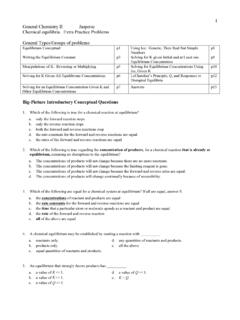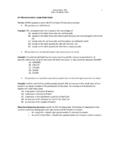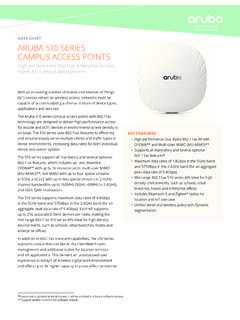Transcription of AP Physics 1 Kinematics - AP Physics @ Woodstock
1 1 AP Physics 1 Kinematics Kinematics Study of Motion Distance Total distance traveled from start to finish. Displacement Straight line distance between the start point and ending point of the problem. Speed A scalar quantity (no direction specified) that shows the rate that distance is covered. Instantaneous The speed at an instant in time. Right now. Your speedometer reading when you glance at it. Average The total distance divided by the total time for the entire trip. Constant If the same speed is maintained over the entire trip Velocity A vector quantity consisting of magnitude and direction.
2 Displacement x divided by time interval. Acceleration Change in velocity over a time interval. Acceleration happens when you speed up, slow down or change direction. Kinematic Equations You can only use the constant velocity equation when there is no acceleration. If acceleration is present (question contains terms such as: starts from rest, final velocity of, accelerates, comes to rest, etc.), then you must use the Kinematic equations in the highlighted boarder boxes below. Constant Speed or Constant Velocity xvt Average Velocity Acceleration oxxvt ovvat ov vat Velocity Rearrange the acceleration equation from above.
3 Useful for determining v, when a and t are given. 212ooxxv tat Position Key equation to determine position when a is involved. Used extensively in free-falling problems where a = g 222oovva x x When no time is given When v, a, and/or x are known, but no information is given about t, then this can be used to solve for the unknown variable. xo initial position, x final position, vo initial velocity, v final velocity, a acceleration, t time Acceleration and Velocity If velocity and acceleration have the same sign: object is speeding up. If velocity and acceleration have opposite signs: object is slowing down.
4 Falling Objects Acceleration: If object fired downward, g = + m/s2 . If object fired upward g = - m/s2 Projectile Motion Motion in two dimensions happens simultaneously. In the x direction the velocity is constant, with no acceleration occurring. In the y direction the acceleration due to gravity slows upward motion and increases downward motion. At the highest point in the trajectory of a projectile only the vertical velocity component vy of the velocity is zero, but the vertical component of the acceleration is g and is directed downward. 2 Kinematics GRAPHS I. Uniform Motion: Constant velocity Position-Time Graph Object is at rest.
5 Object is moving to the left (negative direction). Object is at rest. Velocity-Time Graph Object is at rest. Object is moving in the negative direction at constant speed. Look at the slope of x-t graph. Object is at rest. Acceleration-Time Graph Acceleration is zero in all parts of motion since object is either at rest or moving at constant speed. I. Uniform Accelerated Motion This set of graphs could represent an object thrown up (free fall) Position-Time Graph Object first moves in the positive direction and comes back to the initial position. Velocity-Time Graph Object starts with a positive velocity, slows down while moving in the negative direction.
6 Object changes direction. Object continues moving in the negative direction. Acceleration-Time Graph Acceleration is constant and negative for all parts of motion. 3 GRAPHICAL ANALYSIS PROJECTILE MOTION Projectile fired horizontally and Projectile fired at an angle and object free-falling object thrown up in free-fall A ball rolled off a horizontal table will take the Compare velocities at equal positions on the way up and down. same amount of time to hit the ground as another tup = tdown for objects returning to ground level dropped from the same height.
7 2ytg 02 sinvtg Horizontal component of velocity graphs Vertical component of velocity graphs 4 EXERCISES: 1. A person initially at point P in the illustration stays there a moment and then moves along the axis to Q and stays there a moment. She then runs quickly to R, stays there a moment, and then strolls slowly back to Q .Which of the position vs. time graphs below correctly represents this motion? 2. A person standing at the edge of a cliff throws one ball straight up and another ball straight down at the same initial speed.
8 Neglecting air resistance, the ball to hit the ground below the cliff with the greater speed is the one initially thrown (A) upward. (B) downward. (C) neither they both hit at the same speed. 3. A train car moves along a long straight track. The graph shows the position as a function of time for this train. The graph shows that the train: (A) speeds up all the time. (B)slows down all the time. (C) speeds up part of the time and slows down part of the time. (D) moves at a constant velocity. 4. You are throwing a ball straight up in the air. At the highest point, the ball s (A) velocity and acceleration are zero.
9 (B) velocity is nonzero but its acceleration is zero. (C) acceleration is nonzero, but its velocity is zero. (D) velocity and acceleration are both nonzero. 5. The graph shows position as a function of time for two trains running on parallel tracks. Which is true: (A) At time tB,both trains have the same velocity. (B) Both trains speed up all the time. (C) Both trains have the same velocity at some time before tB. (D) Somewhere on the graph, both trains have the same acceleration. 6. A cart on a roller coaster rolls down the track shown below. As the cart rolls beyond the point shown, what happens to its speed and acceleration in the direction of motion?
10 Ignore any effects of friction. (A) Both decrease. (B) The speed decreases, but the acceleration increases. (C) Both remain constant. (D) The speed increases, but acceleration decreases. (D) Both increase 5 7. Consider the situation depicted here. A gun is aimed directly at a dangerous criminal hanging from the gutter of a building. The target is well within the gun s range, but the instant the gun is fired and the bullet moves with a speed vo, the criminal lets go and drops to the ground. What happens? The bullet (A) hits the criminal regardless of the valueof vo. (B) hits the criminal only if vo is large enough.








